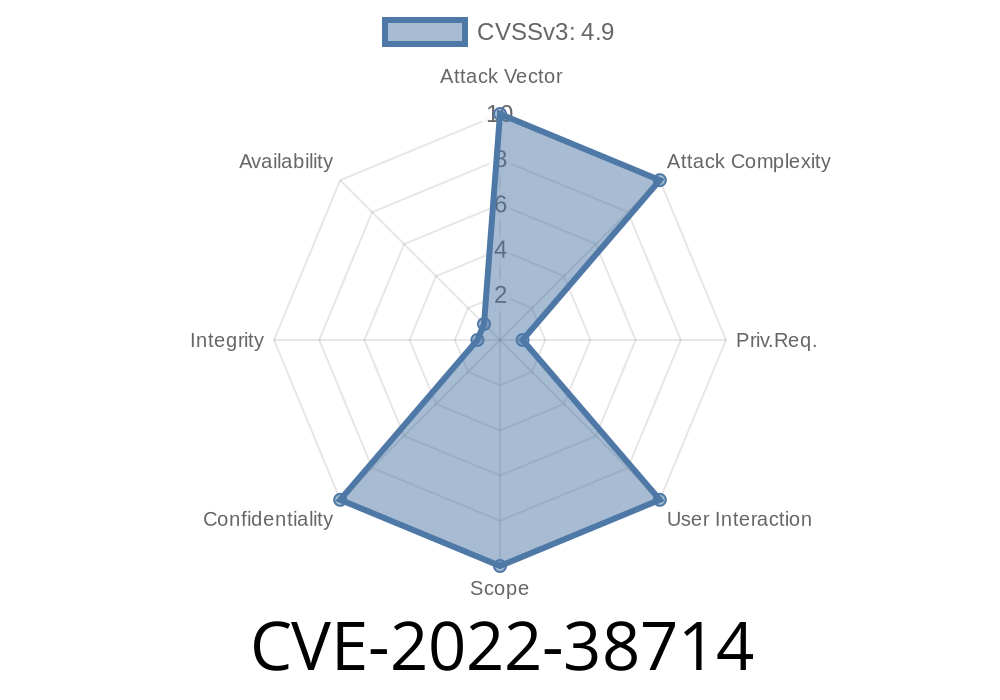CVE-2022-38714 is a notable security vulnerability affecting IBM DataStage on Cloud Pak for Data, versions 4..6 through 4.5.2. If you’re running these versions, your sensitive credential information—like passwords or secrets—could be sitting right on the system in a place a privileged user (like an admin or someone who can see root files) can read it anytime. This post explains how the vulnerability works, how an attacker can exploit it, and what you can do next.
What’s CVE-2022-38714, Plain and Simple?
IBM DataStage, part of the Cloud Pak for Data suite, is used for big data integration. This CVE reveals that in specific versions, DataStage stores credential information (think: database passwords, secret keys) in files or system areas where someone with privileged access—not even a full hacker, but maybe your own system administrator—can open and read the data in plain text.
IBM’s advisory says
> IBM DataStage on Cloud Pak for Data 4..6 to 4.5.2 stores credentials in a recoverable format, exposing sensitive information to local privileged users. (IBM X-Force ID: 235060)
- Official IBM Security Bulletin
- NIST NVD Entry for CVE-2022-38714
Why Is This a Problem?
Credentials should always be encrypted or securely locked away, even on trusted systems. If someone gets privileged access to your server (as a sysadmin, via a stolen account, through another exploit, or even a malicious insider), they could:
Breaking Down the Vulnerability
How does the exposure actually happen?
In affected DataStage versions
- Credentials are saved in configuration or log files (examples: jobParams.json, datastage.config) with weak protection or in readable form.
- File permissions are too broad or follow default Unix group settings, letting more users read them than intended.
Suppose DataStage is running ETL jobs connecting to databases. The database password is stored in a config file so the job can run without asking for it every time. If IBM’s implementation doesn’t encrypt it, anyone with read permissions can open the file and see the credentials.
Example: What the Vulnerable File Might Look Like
{
"db_username": "prod_etl_user",
"db_password": "SuperSecret123!",
"host": "production-db.company.com"
}
Or, in a shell-command context
cat /opt/ibm/datastage/jobs/jobParams.json
# Output:
# {
# "db_username": "prod_etl_user",
# "db_password": "SuperSecret123!"
# }
Suppose /opt/ibm/datastage/jobs/jobParams.json has permissions like -rw-r--r-- or worse for group/world. Anyone in the same group, or any user (on a misconfigured system), could list and read this file.
Here’s how a real attack could go down
1. Privilege Escalation (if needed): The attacker gets admin, operator, or backup-level access. This might be a malicious insider or someone who exploited another flaw.
2. Locate the DataStage Instance: Find the Cloud Pak for Data directory, e.g., /opt/ibm/datastage/.
`bash
grep -Ri "password" /opt/ibm/datastage/
`bash
cat /opt/ibm/datastage/jobs/jobParams.json
`
5. Reuse/Abuse Credentials: Use passwords to connect to databases, impersonate users, or extract data.
Simple Proof-Of-Concept Command
# Find all files with easy-to-read permissions, containing 'password'
find /opt/ibm/datastage/ -type f -exec grep -l "password" {} \; | xargs ls -l
Severity: Medium (depends on privileged access, not remote)
- Reference: IBM X-Force Exchange #235060
How to Fix
IBM’s advisory recommends updating to a fixed version (4.5.3 or later) where credential storage is properly protected or encrypted.
Mitigations if you can’t patch immediately
- Restrict file permissions, only allow the DataStage service user to read sensitive configuration files (chmod 600 filename where possible).
Links to References
- Official IBM Security Bulletin for CVE-2022-38714
- NIST National Vulnerability Database (CVE-2022-38714)
- IBM X-Force Exchange, Vulnerability 235060
Bottom Line
CVE-2022-38714 means IBM DataStage could leak sensitive login data to anyone with the power to browse your system. It’s not a remote bug, but in environments where admins, contractors, or attackers may get local access, this opens the door to bigger breaches.
Update, restrict, and audit now. Don’t let passwords sit around in plain sight—especially on enterprise systems that process your most valuable data.
Timeline
Published on: 02/12/2024 18:15:08 UTC
